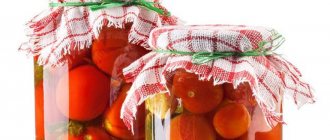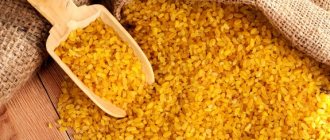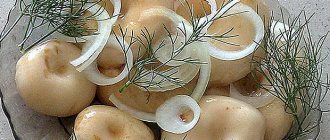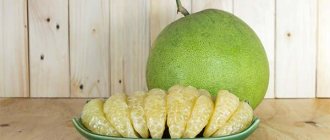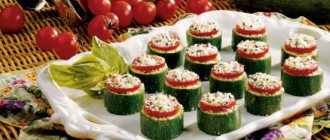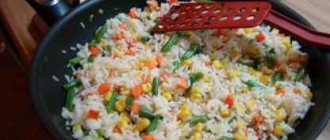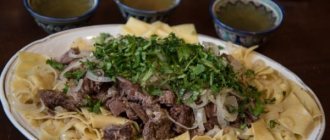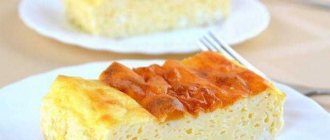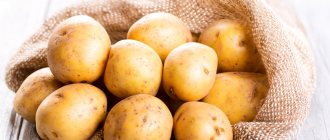How to pickle volushki for the winter in jars in a cold way
A fairly simple way to get a fragrant preparation for the table that will fit perfectly into the holiday menu. With such mushrooms you can also fry potatoes with sour cream - you get a hearty and affordable dish for every day.
Number of servings: 40
Cooking time: 1 hour
Energy value
- calorie content – 24.5 kcal;
- proteins – 2.5 g;
- fats – 0.8 g;
- carbohydrates – 1.7 g.
Ingredients
- wavelets – 2 kg;
- horseradish, leaf – 2 pcs.;
- bay leaf – 4 pcs.;
- table salt – 50-60 g;
- Sunflower oil – 200 ml.
Step-by-step preparation
- Process the jars. It is convenient to use a microwave to sterilize small containers. This method is quite fast, but it is only applicable for small containers. Pour a couple of centimeters of liquid into the jars and heat them in the device compartment (maximum power) for several minutes. Take your time to reach with your hands, open the door and wait until hot steam comes out.
- Place the processed volokhi into the prepared containers (soak them for three days first), sprinkle with a layer of salt and distribute the herbs and spices evenly.
- Fill the surface with hot sunflower oil. Cover with plastic lids.
- When the oil has cooled, place the pickles in the refrigerator for permanent storage. After a couple of months, serve the first batch.
Tip: you can spice up this preparation by including mustard beans and peppercorns in the list of spices.
How to pickle mushrooms. Pickling mushrooms:
Pickling is a traditional ancient way of preserving mushrooms. All varieties of mushrooms can be salted, but lamellar mushrooms, which contain bitter milky juice, are usually prepared this way. They are also called “milkies”. These include milk mushrooms, trumpet mushrooms and others. They are not dried, used for cooking or frying, as the bitterness remains. Mushrooms are usually salted by type, but you can pickle different mushrooms together or place two or three varieties of mushrooms of the same taste in one bowl.
Dry method:
The dry method is used only for harvesting saffron milk caps and hazelnuts. With this salting, mushrooms retain their natural aroma and piquant resinous taste.
Cold way:
In this way, saffron milk caps, milk mushrooms, volushki, and russula are usually salted. Sorted and washed mushrooms (mixing different types is not allowed) are soaked in low, wide tubs with grates and a hole to remove water. The water is changed 2-3 times a day.
Milk mushrooms, podgruzdki, volnushki, smoothies are soaked for 2-3 days, valui, violins, bitters, saffron milk caps are soaked for 3-4 hours to preserve the resinous aroma or just washed thoroughly.
You can salt mushrooms in a cold way by first adding half the amount of salt, and then pouring them with a pre-cooked, filtered and cooled 2.5% salt solution.
Hot salting method:
This method is used for salting honey mushrooms, russula, and honey mushrooms. They are blanched for 5–10 minutes in lightly salted water; honey mushrooms, violins and valui are boiled for 25–30 minutes; saffron milk caps are scalded 2-3 times with boiling water. Thermally treated mushrooms are discarded in a colander and, to give firmness and elasticity, doused with cold water several times, they are allowed to cool. Next, the mushrooms are salted in the same way as in the cold way, and the barrels are sealed. The fermentation process lasts (in days):
- in saffron milk caps - 7–10;
- for milk mushrooms and podgruzdki - 30–35;
- for moths and whitefishes - 40;
- for others - 50–60.
Salted volushki for the winter with garlic: cold method
Another method of cold salting volushki with the addition of garlic, which results in a preparation that can be consumed within a few weeks.
Number of servings: 60
Cooking time: 1 hour 15 minutes
Energy value
- calorie content – 31.7 kcal;
- proteins – 2.8 g;
- fats – 0.8 g;
- carbohydrates – 3.2 g.
Ingredients
- wavelets – 3 kg;
- garlic cloves – 3-4 pcs.;
- bay leaf – 3 leaves;
- rock salt – 150 g;
- dill with seeds - several sprigs;
- cherry leaf – 3 pcs.;
- oak leaf – 4 pcs.;
- pepper – 10 peas.
Step-by-step preparation
- Line the bottom of a pan (preferably enameled) with leaves, dill and a light layer of salt.
- Tamp down a small portion of pre-soaked and blanched mushrooms (no more than six centimeters thick), sprinkle with garlic slices, pepper and bay leaf.
- Repeat the manipulations until the main product runs out. Cover with gauze and then with a plate or a special wooden circle. Set the pressure.
- After 3 days, pay attention to the amount of brine formed during salting. If there is a shortage, add a little clean water or, if possible, place a heavier load.
- Afterwards, you can store it directly in the pan (in this case, the gauze cloth is changed every 14 days) or by placing it in jars.
Important: the stated quantity of mushrooms is based on already soaked mushrooms. You will need more fresh mushrooms.
How to pickle volushki?
There are practically no differences between salting and pickling volushki. The process of pickling is especially similar to hot salting. Here is the prescription.
Required:
- 1 kg of mushrooms;
- 0.3 l of water;
- 1 tbsp. spoon of vinegar essence 70%;
- 15 g sugar;
- 10 g salt;
- 3 pcs. bay leaf;
- 2 g each of cumin and dill;
- 7 pcs. carnation;
- 10 black peppercorns.
Step-by-step preparation:
- Prepare ingredients and soak mushrooms.
- Place the container with water on the fire for 2 minutes, add herbs and spices.
- Add mushrooms and cook for 10 minutes.
- Place the finished product in jars
, add vinegar at the rate of 5 ml per 1 liter of finished product. - Pour over the marinade in which the mushrooms were boiled.
- Cover with lids and store in the refrigerator or cellar.
Watch the video! Pickled trumpets
Volnushki in the forests of the middle zone usually grow from June to October. That is, all summer and half of autumn you can safely collect them and store them for the winter, although the main harvest still occurs in the second half of August and early September. It is then that the mushroom comes into its own and has a high taste.
It is not difficult to distinguish tremors from other mushrooms. They have a characteristic cap that cannot be confused with any other mushroom. Along the edges it is shaggy and woolly. Fans of “silent hunting” for mushrooms know very well that the mushroom is considered a conditionally edible mushroom. That is why before use it must be thermally treated for a long time and very carefully.
Actually, our article today will be devoted to this issue. In most cases, volushki are salted in a variety of ways. We will tell you about the most delicious recipes, thanks to which volushki acquire a special taste and aroma. They go well with almost any side dish, just with bread or in salads with onions and sour cream. Lunch!
General principles for salting tremors
In fact, there are a great many ways to pickle mushrooms. According to some mushroom pickers, mushrooms must be soaked in cold water before salting. Others pour boiling water over them, others boil them altogether, and still others consider this all unnecessary. As for spices, opinions diverge even more, although all hosts and hostesses are right in their own way. In fact, you can salt not only trumpet mushrooms, but also any other mushrooms, with the exception of russula, morels and strings. When salted, russula never loses its bitterness, but morels become loose and lose their taste.
It is recommended to salt volushki in wooden barrels and tubs. Meanwhile, if you do not live in a rural area, this is unlikely to be possible. Where can I get a wooden tub in a city apartment? So if you live in the city and don’t have wooden utensils at hand, use glass or enamel utensils to pickle the fried eggs. The enamel should not be damaged. Salting mushrooms in galvanized tin dishes is unacceptable - as well as in clay pots. You can find such recommendations in many cookbooks, but they have no objective basis. The fact is that during the fermentation process salts and acids can form, which destroy the glaze covering the pottery. Since the glaze contains lead, it dissolves and can cause severe poisoning.
Before salting, glassware is washed well with washing powder or any other detergent. This is done until all foreign odors are removed. Then the dishes are rinsed several times with hot and cold water, scalded with boiling water, and dried in the oven.
How to salt volushki using the cold salting method (with soaking)?
First, we will learn how to salt volushki in cold and salted water. By the way, milk mushrooms, serushki, some types of russula, and other mushrooms are usually salted using the same method.
So, you will need to clean the mushrooms from debris, soil and sand, which are present on the mushrooms in fair quantities. Rinse them thoroughly and fill them with salted cold water at the rate of 0.5 tablespoon of salt per liter of water. It is recommended to change the water about 2-3 times a day, and best of all every 4-5 hours, so that the mushrooms do not sour. Volnushki are usually soaked for 1-2 days. For comparison, mushrooms such as valui can be soaked for 5 or even 6 days.
After soaking, you will need to clean the mushrooms again with a brush or nylon cloth. They are placed in the required dishes with caps down in layers of about 5-7 cm each, sprinkled with coarse salt (necessarily not iodized). Do not skimp on salt - take about 30 grams for every kilogram of mushrooms. Why can't you use iodized salt? It causes rapid souring of the waves.
Now let's go over the spices. The following spices are placed on top of the mushrooms and on the bottom of the dish: 2 grams of bay leaf, gram of allspice per 10 kg of mushrooms. You can also use cloves, blackcurrant and horseradish leaves, cherries, etc. to your taste. If you salted the volushki in a wooden bowl, then cover it with a wooden lid or circle that fits freely into the bowl. Some kind of pressure is placed on top of it. For comparison, if you salt volushki in a 50-liter barrel, the weight of the oppression should be at least 8 kg. Be sure to wash the lid and bend before salting.
The brine usually forms within 2-3 days. Then the mushrooms begin to settle. You drain off the excess brine and add a new portion of mushrooms that have gone through all the processing described above. If after 3-4 days the brine does not appear, your pressure is too weak and you need to increase its mass. Also make sure that the top layer of the waves is constantly covered with brine.
How to salt volushki using the cold salting method (without soaking)?
You clean the mushrooms of debris in the same way, rinse them twice in cold water - preferably salted or acidified. Mushrooms are placed in layers in a container at the rate of 1 kilogram of mushrooms per 30-40 grams of table non-iodized salt. With this type of salting you do not need to use any spices. As for the timing of the readiness of the mushrooms (the so-called fermentation period), they are the same as in the first case. True, the preliminary soaking of the waves lasts 40 days. It is noteworthy that some mushrooms (for example, saffron milk caps, russula) are salted without soaking. Mushroom pickers limit themselves to just washing them in salt water. Salts are added to 5% of the total mass of fresh mushrooms. That is, about 50 grams of salt are taken per kilogram of mushrooms.
How to salt volushki using the hot salting method?
If you don’t want to wait weeks for delicious mushrooms, if you simply don’t have time, you can try hot pickling of mushrooms. Within a day or two after hot salting, you will be able to eat russula. As for the waves, you will have to wait 6-7 days. But it’s still much faster than cold salting.
Volnushki are scalded with boiling water, but not boiled, but simply kept in hot water for about half an hour. Then the boiled mushrooms are placed in a colander, allowed to drain, washed in cold water and salted in the same sequence as for cold salting. It is extremely important that all pickled mushrooms are stored exclusively in a cool place at a temperature not below zero and not above 10 degrees. Thus, storing mushrooms at elevated temperatures will invariably lead to souring of the mushrooms. If mold appears on the brine, do not be alarmed. Just remove it and rinse the oppression with the circle thoroughly in boiling water. If the temperature is below zero, the mushrooms will simply freeze and begin to crumble, which is also not good.
What can be prepared from salted trumpets?
You can make a delicious salad, an appetizing mushroom sauce or a filling for pies from the mushrooms, salted and chopped together with onions. You can also cook mushroom soup, prepare hodgepodge or mushroom pickle. If you wash the salted mushrooms in several waters, boil them in milk or water, then they will taste like fresh ones. After this treatment, the mushrooms are fried and then used to prepare both first and second courses.
How to store salted trumpets?
Mushrooms such as tremors are stored in a cool and well-ventilated area at a temperature of 5-6 degrees, but not below zero. Make sure that your mushrooms are constantly in the brine. If it evaporates and does not cover the mushrooms, it is advisable to add cooled boiled water to the dishes. If mold appears, wash the fabric and circle in hot, slightly salted water. Mold that has appeared on the walls of the dishes is wiped off with a clean cloth soaked in hot water.
Please note that mushrooms are not completely preserved in a salt solution, since in such an environment the activity of microorganisms is limited, but it does not stop. The thicker the brine, the better the mushrooms will be preserved. Meanwhile, in this case, the mushrooms become so over-salted that they completely lose their value.
Another important point. If you do not want mold to appear on the surface of the mushrooms, place them in hermetically sealed containers and be sure to store them in a dry and cool place. Under no circumstances is it recommended to cover jars with cellophane or parchment paper. In a damp, warm room, the water in the jars will begin to evaporate, causing the mushrooms to simply become moldy.
Volnushki appear in the summer in July. White and pink trumpet mushrooms are classified as conditionally edible mushrooms, so this mushroom is usually salted.
Hot salting is faster and gives you the opportunity to try the product after just a few days. Boiled mushrooms immediately lose volume and fill the container tightly, without shrinking. But hot pickling of volushka mushrooms can make them softer.
Before storing for the winter, trumpet mushrooms and other mushrooms with an abundance of bitter milky juice need to be soaked. For the same reason, drying volnushki is not allowed.
To do this, place them in cold salted water with the addition of citric acid and leave for a day. For a liter of water you need to take 10 g of salt and 2 g of citric acid. The water needs to be changed at least two to three times a day. Afterwards, rinse the waves in running water and dry.
Hot salting is used when preparing many mushrooms for future use, including mushrooms. The stems of mushrooms that have been cleared of debris, soaked in water, and washed are usually cut off (they are salted separately).
Large caps, if they are salted together with small ones, are cut into 2-3 parts. Then salted water (10 g of salt per liter of water) is poured into an enamel bowl and put on fire. There shouldn't be a lot of water.
Hot salting of tremors
After boiling, put the mushrooms in it and cook, stirring so as not to burn. Properly welded volushki remain strong and elastic.
Some mushroom pickers, instead of boiling, pour boiling water over the mushrooms for 10-20 minutes, changing the boiling water 3-4 times after cooling.
Order an energy saver and forget about the previous huge expenses for electricity
During the boiling process, remove all the foam from the mushrooms with a slotted spoon, after which spices and roots, except bay leaves, are added. They need to be placed directly into the pickling bowl along with chopped garlic cloves.
For 1 kg of prepared mushrooms you usually put:
- 2 tablespoons salt
- a couple of bay leaves
- 2-3 blackcurrant leaves
- 4-5 cherry leaves
- 3-4 black peppercorns
- 3 clove buds
- 5 g dill seed
You can also add cumin and garlic.
The volnushki in the marinade are boiled from the moment of boiling for 10-15 minutes. The mushrooms are considered ready when they settle to the bottom and the brine becomes clear.
Then they are carefully transferred into a wide bowl to cool faster, then into jars, filled with brine, to which you need to add salt - 1.5 tbsp. spoons per liter, add garlic and bay leaf. In this case, the liquid should be no more than 1/5 of the volume of the mushrooms, but they should be completely covered with brine.
A clean napkin is placed on top, and a wooden circle and pressure are placed on it. They are kept in the refrigerator for a day, then the salted volushki are rolled into sterilized jars.
There is a hot method of salting volushki, and it is slightly different. The mushrooms are boiled in salted water without spices, placed in a sieve, washed with cold boiled water and allowed to dry.
Then you can pickle the mushrooms using the hot salting method in the same way as, that is, placing mushrooms, seasonings and salt in layers in a container at the rate of 2-3% by weight of the mushrooms. Pour over the same brine in which it was cooked, put dill umbrellas and garlic on top. It is also recommended to pour a 1 cm layer of vegetable oil on top.
They will be ready in about a month. Such salted mushrooms should be stored in a cold, ventilated area at a temperature from 0 to +3...+4ºС.
Volnushka is a mushroom belonging to the Milky genus, the Russula family. Most often you can find pink and white wave. They certainly grow in sandy and siliceous soil in the forest. Favorable soil is found under the birch trees.
The mushroom cap is not wide, the maximum value was 11 cm, and on average it reaches no more than 8 cm. A young mushroom has a convex cap, which begins to fall in with age. The edges are always turned inward. On the surface of the cap there are thick hairs that hang from the ends, which gives the mushroom a certain peculiarity. The older the plant, the less noticeable the braids.
The cap is pale pink, but when exposed to sunlight it can turn yellow. The pulp has the same color, dense and dry structure.
All the plates of the wavefish are the same color as the cap, but sometimes they can be paler. When cut, it releases bright yellow juice and does not change when exposed to air.
Compared to the cap, the stem is much paler, but at the same time has a dense structure. The surface is smooth. In rare cases, minor dark depressions can be observed on the surface. It is even less common to be hollow. The stem of the mushroom reaches no more than 6 cm.
The edible trumpet has interesting taste characteristics. In its raw form, the mushroom cannot be eaten due to its caustic nature, but when cooked it acquires a pleasant taste. But with any heat treatment, the product retains its natural pungency. When cooked, it completely loses its bitterness. The smell does not change, remains the same pleasant, earthy.
Recipe for hot salted trumpets
Despite the need to boil the mushrooms, as a result of cooking they do not stop crunching. The hot method has become more widespread due to the unpretentious storage conditions for pickling - the temperature can be within 16 degrees.
Number of servings: 30
Cooking time: 1 hour
Energy value
- calorie content – 30.8 kcal;
- proteins – 2.7 g;
- fats – 0.9 g;
- carbohydrates – 3.1 g.
Ingredients
- volukha – 1.5 kg;
- table salt – 30 g;
- black pepper – 4 peas;
- allspice – 5 peas;
- spicy cloves – 5 buds;
- garlic – 4 cloves;
- laurel – 6 pcs.;
- blackcurrant leaf – 4 pcs.
Step-by-step preparation
- Boil raw volushki in one liter of water for about a quarter of an hour, after properly preparing them. Remove foam regularly. Then drain in a colander to preserve the resulting broth.
- Place the volokhi tightly in an enamel-coated pan, pour salt on top and add spices.
- Add chopped garlic cloves here. Pour in newly boiled mushroom broth.
- Install the weight. When the snack reaches room temperature, transfer to the refrigerator for 12 hours.
- After the specified time has passed, distribute the product into still hot sterile containers. Cork.
This is interesting: there is a third way to close Volzhanka - a combined one. The technology remains the same - the mushrooms are boiled, however, the time is reduced to ten minutes and the product is placed in already bubbling water. Volnushki are prepared without adding decoction in their own juice under heavy pressure.
Why soak the waves?
Volnushka is soaked before any method of further culinary processing: salting, boiling, frying or pickling. The main task of this procedure is to remove juice. It has an unpleasant bitter taste that will spoil any dish.
Important! Soaking will not rid the mushrooms of toxins and heavy metals, so it is prohibited to collect these mushrooms along roads or near industrial areas.
Recipe for canned trumpets
Pickled trumpets are a snack that can be prepared quickly and tasty, thanks to the vinegar included in the composition. This preparation is distinguished by the mild spiciness of the marinade, and additional ingredients can be combined at your discretion. Grain mustard will give the preservation a pleasant shade, and caraway seeds will give it a refined spice. You can also add a few slices of onion and carrots to the jar.
Number of servings: 20
Cooking time: 50 minutes
Energy value
- calorie content – 33.2 kcal;
- proteins – 2.7 g;
- fats – 0.8 g;
- carbohydrates – 3.7 g.
Ingredients
- mushrooms – 1 kg;
- bay leaf – 2 leaves;
- coarse salt – 10 g;
- cloves - 6 buds;
- dill/seeds – 2 g;
- granulated sugar – 15 g;
- peppercorns – 10 pcs.;
- vinegar essence (70%) – 5 ml;
- purified water – 300 ml.
Step-by-step preparation
- Boil the peeled and soaked mushrooms until fully cooked. When the fritters settle to the bottom of the pan, transfer to a large sieve and leave to cool.
- Treat jars with lids. The specified number of components will yield about two half-liter containers. They can be boiled in water for 15 minutes, then carefully removed and left to dry.
- Prepare the marinade. Add everything except the essence to the liquid and boil for a couple of minutes. Add the Volzhanka and leave on the stove for another 10 minutes.
- Place the mushrooms in a container, pressing down gently with a spoon. Add marinade to the edges. Tighten with a special key.
Advice: volnushki are suitable for making searing, but it is highly not recommended to freeze them in the freezer or dry them. This mushroom is completely unsuitable for this type of preparation.
Volnushki according to any of the given recipes will be an excellent appetizer on any table.
In addition, this is an easy way to replace meat products during Lent. Bon appetit! Did you like the recipe? Save it to your Pinterest! Hover over the image and click “Save.”
Description
Cold salted volnushki is a wonderful appetizer dish of Russian cuisine. True, the peculiarity of volnushki is that they are somewhat bitter, but this problem can be dealt with by regular soaking. Gradually, the milky juice will come out of the mushrooms, and they will stop being bitter. And soaked waves are much easier to clean.
We will salt the mushrooms in a cold way, that is, without boiling, in order to preserve the maximum of nutrients and vitamins in them. After all, volnushki are a very useful mushroom. Their beneficial effect, first of all, affects the cardiovascular system, since the microelements contained in volnushki strengthen blood vessels and prevent the deposition of cholesterol. So pampering yourself with these wonderful mushrooms is not only tasty, but also healthy for the body.
Our step-by-step recipe with photos will help you prepare cold-salted volushki at home. Preparing the dish is not difficult, but it takes a long time, since in order to properly salt the mushrooms, it takes at least a month. But then you can fully enjoy a wonderful snack. By the way, if you decide to pickle saffron milk caps, milk mushrooms, and scallops in the same way, it will turn out no worse.
Video
How else can you salt volushki - recipes can be seen in the following videos:
Freelancer with diverse interests and hobbies. Likes to be close to nature, eat delicious food and philosophize about the eternal. She has been writing articles on a variety of topics for so long that she is already erudite in the most unexpected areas. Loves forests, flowering gardens, space and fried potatoes with smoked ribs. He doesn’t like to stand at the stove, but among his friends there are several professional chefs who will always feed you delicious food and share cool recipes. Pathologically optimistic.
Found a mistake? Select the text with the mouse and click:
Compost is rotted organic remains of various origins. How to do it? They put everything in a heap, hole or large box: kitchen scraps, tops of garden crops, weeds cut before flowering, thin twigs. All this is layered with phosphate rock, sometimes straw, earth or peat. (Some summer residents add special composting accelerators.) Cover with film. During the process of overheating, the pile is periodically turned or pierced to bring in fresh air. Typically, compost “ripens” for 2 years, but with modern additives it can be ready in one summer season.
Tomatoes have no natural protection against late blight. If late blight attacks, any tomatoes (and potatoes too) die, no matter what is said in the description of the varieties (“variety resistant to late blight” is just a marketing ploy).
You need to collect medicinal flowers and inflorescences at the very beginning of the flowering period, when the content of nutrients in them is highest. Flowers are supposed to be picked by hand, tearing off the rough stalks. Dry the collected flowers and herbs, scattered in a thin layer, in a cool room at natural temperature without access to direct sunlight.
A new product from American developers is the Tertill robot, which weeds weeds in the garden. The device was invented under the leadership of John Downes (creator of the robot vacuum cleaner) and works autonomously in all weather conditions, moving over uneven surfaces on wheels. At the same time, it cuts off all plants below 3 cm with the built-in trimmer.
Oklahoma farmer Carl Burns developed an unusual variety of multi-colored corn called Rainbow Corn. The grains on each cob are of different colors and shades: brown, pink, purple, blue, green, etc. This result was achieved through many years of selecting the most colored ordinary varieties and crossing them.
The homeland of pepper is America, but the main breeding work on developing sweet varieties was carried out, in particular, by Ferenc Horvath (Hungary) in the 20s. XX century in Europe, mainly in the Balkans. Pepper came to Russia from Bulgaria, which is why it received its usual name - “Bulgarian”.
Both humus and compost are rightfully the basis of organic farming. Their presence in the soil significantly increases the yield and improves the taste of vegetables and fruits. They are very similar in properties and appearance, but they should not be confused. Humus is rotted manure or bird droppings. Compost is rotted organic remains of various origins (spoiled food from the kitchen, tops, weeds, thin twigs). Humus is considered a higher quality fertilizer; compost is more accessible.
From varietal tomatoes you can get “your own” seeds for sowing next year (if you really like the variety). But it is useless to do this with hybrids: you will get seeds, but they will carry the hereditary material not of the plant from which they were taken, but of its numerous “ancestors”.
In Australia, scientists have begun experiments in cloning several varieties of grapes grown in cold regions. Climate warming, which is predicted for the next 50 years, will lead to their disappearance. Australian varieties have excellent characteristics for winemaking and are not susceptible to diseases common in Europe and America.
In deciduous forests, birch groves, along the edges of reservoirs, streams and lakes, you can often find wave mushrooms - attractive-looking mushrooms with flat pink or white caps. The specificity of their preparation is such that before preparing delicious dishes, mushrooms must be processed. It’s worth learning more about how to soak the mushrooms before salting, frying or boiling ahead of the “hot” summer season of mushroom preparations.
